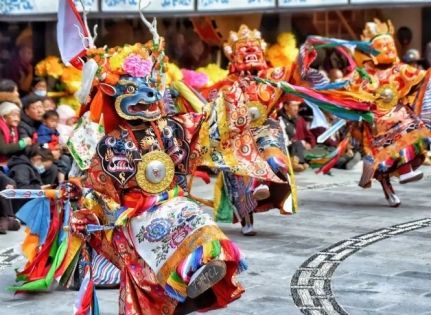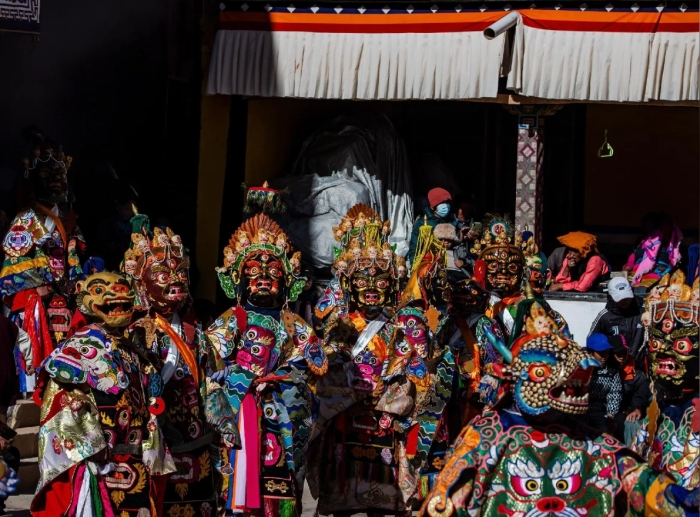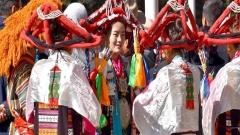The Cham Dance is one of Tibet’s most fascinating and mysterious religious rituals. More than just a performance, it is a sacred practice where masked monks embody deities, drive away evil spirits, and bless the community. For travelers to Tibet, witnessing the Cham Dance offers an unforgettable window into Tibetan Buddhism, spirituality, and cultural identity.
What Is the Cham Dance?
Cham is a traditional masked dance performed by Tibetan Buddhist monks, usually during major religious festivals. The word “Cham” means “masked dance” in Tibetan, and each movement carries symbolic meaning. Unlike ordinary cultural shows, Cham is considered a ritual offering to deities, a prayer for peace, prosperity, and protection from negative forces.
It combines music, dance, drama, and meditation, turning temple courtyards into sacred stages where spiritual and artistic worlds merge.

cham dance
Historical Origins of Cham Dance
The Cham Dance dates back over a thousand years and is believed to have originated in Indian and Tibetan Tantric traditions. According to legend, Guru Padmasambhava, who brought Buddhism to Tibet in the 8th century, used sacred dances to subdue demons and protect the Dharma.
Over time, Cham became a central feature of Tibetan Buddhist rituals, especially within monasteries of the Gelug, Nyingma, and Kagyu schools. Each lineage developed its own variations, but all share the same goal: purifying the environment and guiding sentient beings toward enlightenment.
Spiritual and Cultural Significance
Cham Dance is not mere entertainment; it is an act of meditation in motion. For the monks performing it, every step and gesture represents prayers to deities and guardians. For local Tibetans, watching Cham is a form of receiving blessings and protection.
Key spiritual meanings include:
-
Dispelling negative energies and driving away evil spirits.
-
Honoring protective deities and enlightened beings.
-
Teaching Buddhist philosophy through symbolic movements.
-
Strengthening community harmony during religious gatherings.
For travelers, Cham is a chance to witness how deeply intertwined religion and daily life are in Tibet.
The Masks and Costumes
One of the most striking features of Cham is the elaborate masks and costumes worn by the monks.
-
Masks: These often depict wrathful deities, dharma protectors, or animal figures. The fierce expressions are not meant to frighten but to symbolize the power of wisdom destroying ignorance.
-
Costumes: Heavy brocade robes, colorful aprons, and embroidered boots enhance the grandeur of the dance. Some monks wear large, decorated hats or crowns to represent different spiritual beings.
-
Colors and symbols: Every detail, from the mask color to the hand-held ritual implements, carries meaning rooted in Buddhist cosmology.
For visitors, the vibrant visual impact of the masks and costumes is unforgettable.
Music and Movements
Cham Dance is performed to the deep, resonant sounds of long Tibetan horns, drums, and cymbals. The music sets a trance-like atmosphere, guiding both monks and spectators into a sacred space.
Movements range from slow, meditative steps to vigorous spins and leaps. Each choreography corresponds to Buddhist teachings: the slow circling may symbolize the wheel of life, while sudden stomps represent the destruction of evil forces.
The combination of sound, movement, and symbolism creates a performance that feels both otherworldly and profoundly spiritual.
Where and When to See Cham in Tibet
Travelers can witness Cham Dance during major religious festivals across Tibet. Some of the best places and occasions include:
-
Monlam Festival (Great Prayer Festival) in Lhasa — often held after Losar (Tibetan New Year).
-
Shoton Festival (Yogurt Festival) at Drepung Monastery, featuring grand ceremonies with Cham dances.
-
Cham at Tsurphu Monastery — linked to the Karma Kagyu tradition, known for its unique variations.
-
Samye Monastery festivals — often include Cham as part of large-scale rituals.
-
Smaller local monasteries in regions like Chamdo, Shigatse, and Ngari, where Cham has a more intimate community atmosphere.
Travelers should check festival dates in advance, as Tibetan festivals follow the lunar calendar and change each year.
How Travelers Can Experience It Respectfully
For visitors, Cham is a sacred ritual, not just a tourist attraction. To fully appreciate it, keep these tips in mind:
-
Dress modestly: Avoid overly casual or revealing clothing.
-
Be respectful with photography: Always ask if photos are allowed; in some monasteries, it may be restricted.
-
Observe in silence: Avoid loud conversations, laughter, or disruptive behavior.
-
Join locals with offerings: Some Tibetans bring small donations or butter lamps as part of the ritual.
-
Stay curious but humble: Remember that the dance is performed primarily for spiritual purposes, not tourist entertainment.
By respecting these customs, travelers can deepen their cultural understanding while honoring local traditions.
The Global Spread of Cham
Interestingly, Cham is no longer confined to Tibet. Tibetan Buddhist communities in Bhutan, Nepal, Mongolia, and even the West also perform Cham during festivals. While styles vary, the essence remains the same: sacred dance as meditation and protection.
For international audiences, Cham has become a bridge to Tibetan culture, offering insight into its philosophy of compassion, impermanence, and the victory of wisdom over ignorance.
Why You Shouldn’t Miss Cham Dance
Cham Dance is more than a performance — it is a living, breathing expression of Tibetan Buddhism. Watching it gives travelers a rare opportunity to:
-
Witness an ancient ritual unchanged for centuries.
-
Experience Tibetan culture in its purest form.
-
Gain spiritual inspiration, even as an outsider.
-
Take home unforgettable memories of one of Tibet’s most unique traditions.
Conclusion
The Cham Dance is one of the most powerful cultural experiences in Tibet. With its sacred masks, mesmerizing music, and deep spiritual meaning, it offers a glimpse into the soul of Tibetan Buddhism. For those who journey to Tibet, witnessing Cham is not just a highlight of travel — it is a transformative encounter with a tradition that continues to inspire, protect, and bless its people.














